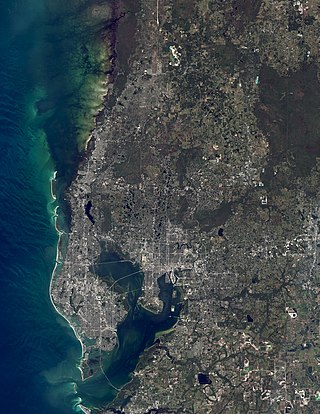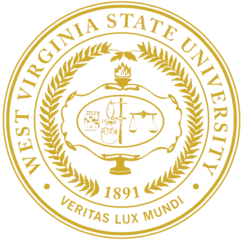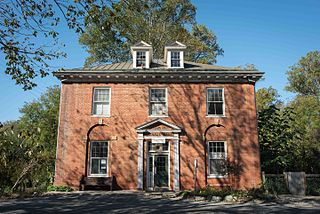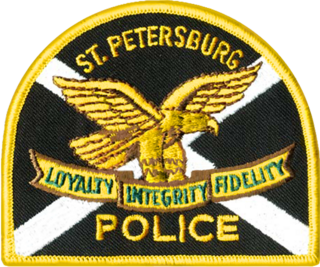
Pinellas County is located on the west central coast of the U.S. state of Florida. As of the 2020 census, the population was 959,107, making it the seventh-most populous county in the state. It is also the most densely populated county in Florida, with 3,491 residents per square mile. The county is part of the Tampa–St. Petersburg–Clearwater Metropolitan Statistical Area. Clearwater is the county seat. St. Petersburg is the largest city in the county, as well as the largest city in Florida that is not a county seat.

St. Petersburg is a city in Pinellas County, Florida, United States. As of the 2020 census, the population was 258,308, making it the fifth-most populous city in Florida and the most populous city in the state that is not a county seat. It is the second-most populous city in the Tampa Bay area, which is the second-largest metropolitan area in Florida with an estimated population of about 3.29 million in 2022.

Pinellas Park is a city located in central Pinellas County, United States. The population was 53,093 at the 2020 census. The city is the fourth largest city in Pinellas County. The City of Pinellas Park was incorporated in 1914. It is part of the Tampa–St. Petersburg–Clearwater Metropolitan Statistical Area, most commonly referred to as the Tampa Bay Area.

Pocahontas is a town in Tazewell County, Virginia, United States. It was named for Chief Powhatan's daughter, Pocahontas, who lived in the 17th-century Jamestown Settlement. The town was founded as a company mining town by the Southwest Virginia Improvement Company in 1881. It was the first company mining town in Virginia. The post office opened on June 30, 1882.

The Tampa Bay area is a major metropolitan area surrounding Tampa Bay on the Gulf Coast of Florida in the United States. It includes the main cities of Tampa, St. Petersburg, and Clearwater. It is the 17th-largest metropolitan area in the United States, with a population of 3,175,275 as of the 2020 U.S. census.

Carter Godwin Woodson was an American historian, author, journalist, and the founder of the Association for the Study of African American Life and History (ASALH). He was one of the first scholars to study the history of the African diaspora, including African-American history. A founder of The Journal of Negro History in 1916, Woodson has been called the "father of black history." In February 1926, he launched the celebration of "Negro History Week," the precursor of Black History Month. Woodson was an important figure to the movement of Afrocentrism, due to his perspective of placing people of African descent at the center of the study of history and the human experience.

West Virginia State University (WVSU) is a public historically black, land-grant university in Institute, West Virginia, United States. Founded in 1891 as the West Virginia Colored Institute, it is one of the original 19 land-grant colleges and universities established by the second Morrill Act of 1890, which evolved as a diverse and inclusive campus. Following desegregation, WVSU's student population slowly became more white than black. As of 2017, WVSU's student body was 75% white and only 8% African-American.

Busch Gardens Tampa Bay is a 335-acre (136 ha) animal theme park located in Tampa, Florida, United States, with the entire park landscaped and designed around themes of Africa and Asia. Owned and operated by United Parks & Resorts, the park opened on June 1, 1959. The park has an annual attendance consistently exceeding 4 million, often ranking second among United Parks & Resorts parks behind SeaWorld Orlando.
HOPE VI is a program of the United States Department of Housing and Urban Development. It is intended to revitalize the most distressed public housing projects in the United States into mixed-income developments. Its philosophy is largely based on New Urbanism and the concept of defensible space.

Carter G. Woodson Home National Historic Site at 1538 9th Street NW, in the Shaw neighborhood of Washington, D.C., preserves the home of Carter G. Woodson (1875–1950). Woodson, the founder of Black History Month, was an African-American historian, author, and journalist.

Richard Murray "Rick" Baker is an American attorney and politician who served as mayor of St. Petersburg, Florida. Elected in 2001, he was reelected in November 2005 with almost 70% of the vote.

Esmont is a census-designated place (CDP) in Albemarle County, Virginia, United States. The population as of the 2020 Census was 491.

The St Petersburg Police Department (SPPD) provides crime prevention and public safety services for the city of St. Petersburg, Florida. The department was created in 1903. The St. Petersburg Police Department has an authorized strength of 550 sworn officers and 212 civilian support staff. The department serves the fifth largest city in the state of Florida, with a population of 250,000. The St. Petersburg Police Department is one of over 1,000 law enforcement agencies in the United States accredited by the Commission on Accreditation of Law Enforcement Agencies (CALEA). Anthony Holloway is the chief of police.
Gibbs Junior College was created in 1957 by the Pinellas County Board of Public Instruction to serve African-American students in St. Petersburg, Florida. It was the first and most successful of Florida's eleven new African-American junior colleges, founded in an unsuccessful attempt to avoid the racial integration mandated by the unanimous 1954 Supreme Court Brown v. Board of Education decision. It was named for the minister and abolitionist Jonathan C. Gibbs, who opened a private school for freed slaves after the Civil War, and was later Florida's Secretary of State (1868–1872) and then Superintendent of Public Instruction, the first African-American member of the Florida Cabinet.

The Griot Museum of Black History is a wax museum in St. Louis, Missouri, founded in 1997. Originally named The Black World History Wax Museum, the organization changed its name to The Griot Museum of Black History in 2009. In some west African countries, the griot, is a historian, storyteller, praise singer, poet and/or musician. The griot is a repository of oral tradition and is often seen as a societal leader who preserves and shares cultural traditions of a community. Likewise, the museum collects, preserves, and shares the stories, culture, and history of Black people with a focus on those with a regional connection to St. Louis.
The Associated Publishers was a producer of printed materials, founded by historian Carter G Woodson in June 1921. The publishing company was founded to initially help Woodson produce his own works and helped many other scholars of black history deliver their works to the public.
Elder Jordan Sr. was an American businessman, philanthropist, and community leader in St. Petersburg, Florida. He was an important figure in African American history of St. Petersburg by the creation of a social gathering place in the 1920s through 1960s, as well as through the donation of his land to create public housing. He is the namesake of the Jordan Park neighborhood of St. Petersburg.
Herman H. Dreer (1888–1981) was an American academic administrator, educator, educational reformer, activist, author, editor, Baptist minister, and civil rights leader. He is best known for writing curriculum and programming for teaching African American History at most grade levels for early 20th-century public schools. Dreer is also credited with initiating Black History Month observance in the United States, alongside Carter G. Woodson.
The history of libraries for African Americans in the United States includes the earliest segregated libraries for African Americans that were school libraries. The fastest library growth happened in urban cities such as Atlanta while rural towns, particularly in the American South, were slower to add Black libraries. Andrew Carnegie and the Works Progress Administration helped establish libraries for African Americans, including at historically Black college and university campuses. Many public and private libraries were segregated until after the U.S. Supreme Court ruling of Brown v. Board of Education (1954).

The African American Heritage Trail is a self-guided walking tour created by the African American Heritage Association, a St. Petersburg, Florida non-profit organization "dedicated to preserving and teaching the rich history of black St. Petersburg." The trail is divided into two trails: one which runs along 22nd Street S and one along 9th Ave S. Both trails start at the Dr. Carter G. Woodson African American Museum.

















